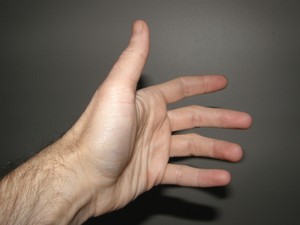An EMG test will determine if you have a deadly neurological disease, as well as many benign conditions. But exactly is involved during an EMG test? (Does it hurt?) I sat in on an EMG test that was recently done on my mother, and it’s actually a very fascinating invention of medical technology.
The EMG test on my mother took about an hour, maybe a tiny bit longer, but some of that time was spent by the doctor pausing to explain things related to her suspected condition (pronator syndrome or carpal tunnel syndrome). The doctor will place very small sticker-like patches on the patient’s body, at the location of the symptoms. He’ll then attach recording electrodes nearby these stickers. The electrodes are attached to a computer that’s a little bulkier than a laptop.
Preceding the actual testing, the doctor will type a lot of things into the computer. To measure nerve conductivity, the doctor must provide an electric shock to the patient with a two-pronged device about the size of a cell phone. When he delivers the shock, the result appears on the computer screen as a jagged horizontal line with a plus sign. Moments later two more images (jagged horizontal lines or sine waves) will appear, one reflecting the muscle activity, and one reflecting nerve activity.
The computer also shows the number of milliseconds it took for the nerve impulse to be conducted. The doctor at one point said that 4 milliseconds was normal, and 10 milliseconds was abnormal; that 50 meters per second was normal, and 42 meters per second was slow.
The patient may not be able to see the computer when all this is happening; my mother was lying on her back while the doctor conducted the EMG test on her right arm first. He suspected pronator teres syndrome, but he also suspected carpal tunnel syndrome.
He was heavily favoring pronator teres syndrome, though he concentrated the initial testing at the wrist and fingers. He very soon announced that she had carpal tunnel syndrome. At this point it was not speculation; it was a 100 percent positive diagnosis, because the EMG test can determine 1) if nerves are firing normally, and 2) if numbness, tingling and strength loss are caused by a healthy nerve signal merely being blocked from arriving at its destination, as in my mother’s case of carpal tunnel syndrome.
The EMG test involves the doctor moving around the various stickers and recording electrodes, then administering a shock at various points higher up from where the recording devices are; in my mother’s case, many of the shocks were delivered to her forearm.
In between the adjustments with the stickers and electrodes, he placed a tape measure to her skin to measure the length of the nerves. The patient, if lying down and unable to see what the doctor is doing, will feel the doctor moving around the stickers and attaching the recording electrodes, then running a tape measure along the skin, and then the electric shock.
The voltage of the shock can be adjusted, and it can be very unpleasant, though it lasts a second. The other thing that the patient will feel is pin pricks. The needle is a little thicker than an acupuncture needle, and the doctor will place a needle at varying locations as part of the EMG test. In the case of my mother, it appeared at one point that he embedded the needle a quarter of an inch into her palm. The “poke” he did there hurt to high heaven based on my mother’s reaction, but again, it was only for a fraction of a second.
The doctor also had her press her arm against resistance a few times. Since all he needed was her arms, she was able to maintain any leg position she was comfortable with. An EMG test does not require the patient to be sedated.
So now you know what’s involved in an EMG test. If you are scheduled for an EMG test, there is nothing to be afraid of, as far as how the procedure feels on your body. If the idea of electric shocks and pin pricks has you unnerved (no pun intended), remember, this test is a godsend for doctors, and it has to be done to provide a diagnosis for your condition (or to rule out an imagined condition).
